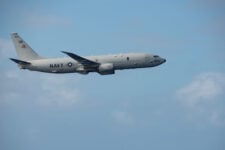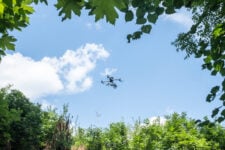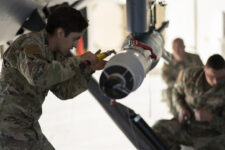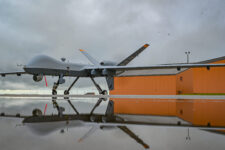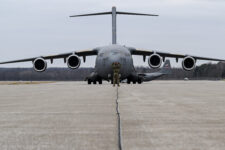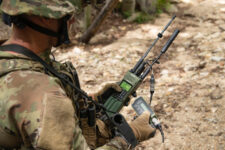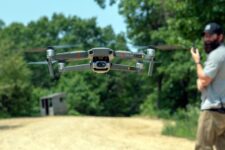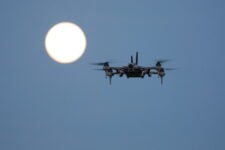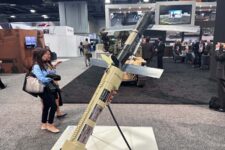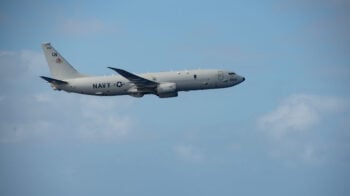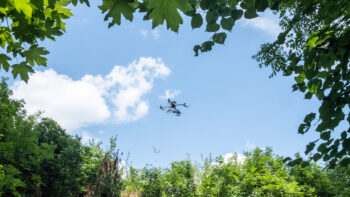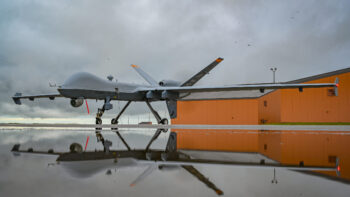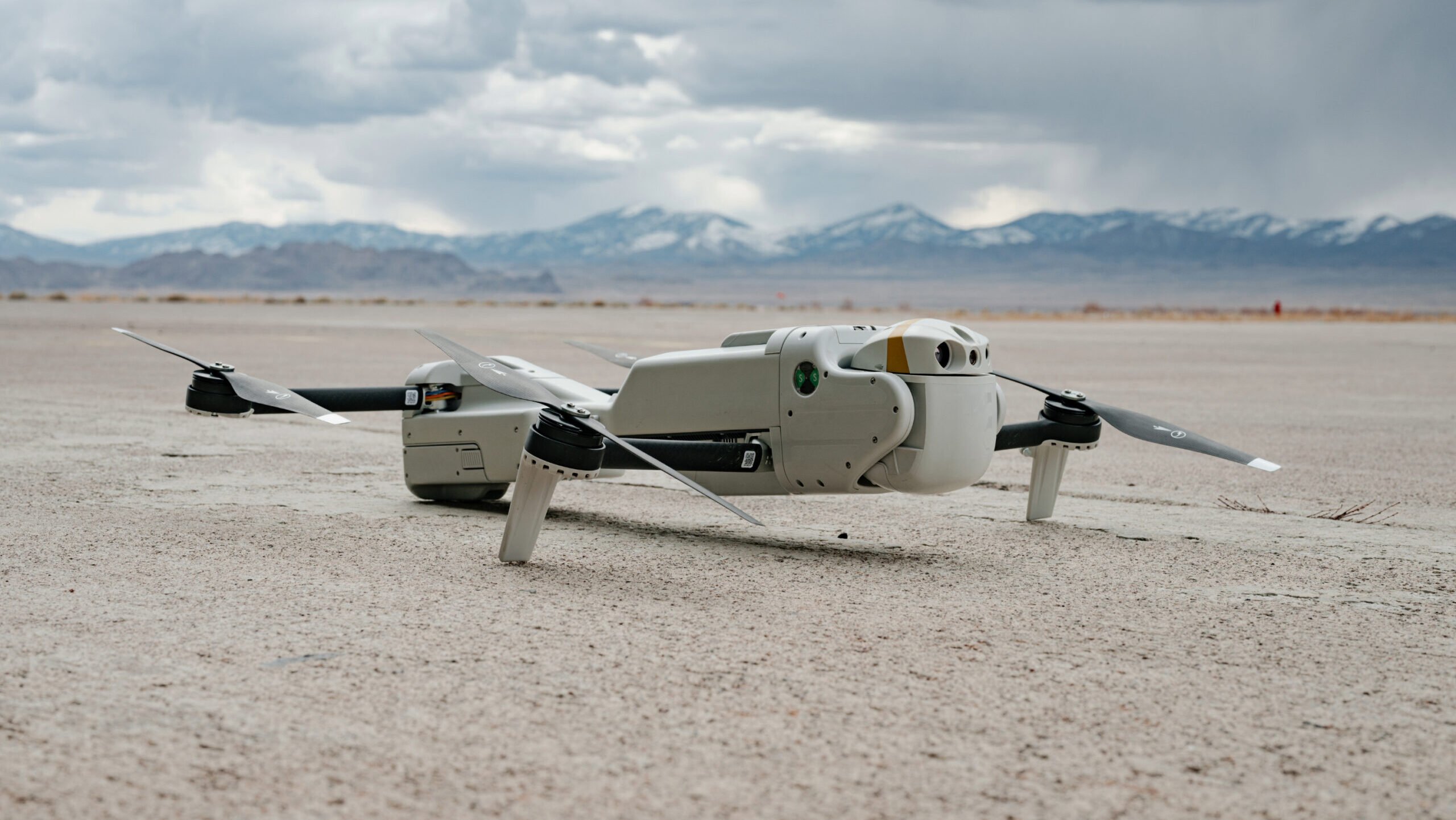
The Teledyne FLIR Rogue 1 loitering munition is seen in company promo art. (Teledyne FLIR)
LONDON — When Teledyne FLIR unveiled its “new” Rogue 1 loitering munition system (LMS) on May 7, it was the first glimpse the public got of the design. But quietly, US Special Operations Command has been testing the vertical take-off/landing capability system for over two years, Breaking Defense has learned.
The company has been under a training and evaluation contract with SOCOM since 2022 as part of the Ground Organic Precision Strike System Echelon 0-Air (0A) requirement. Teledyne FLIR Defense’s Dave Salter, director of US Business Development, confirmed the company continues to deliver “additional systems” to SOCOM.
GOPSS 0A is sub-divided into three categories including ‘nano-’, ‘micro-’ and ‘mega-’ sized platforms. Weighing approximately 10lbs, Rogue 1 satisfies the micro category; Rogue 1 is the only system currently being tested in that category, with the other categories yet to be fulfilled.
In response to questions from Breaking Defense, a SOCOM spokesperson said the command “is using a multi-phase approach to field Ground Organic Precision Strike Systems Echelon 0 Air Micro capabilities, which began with competitive demonstration and down select of the Teledyne FLIR Rogue 1.
“Our next step is to purchase limited quantities of the Rogue 1 for further test and evaluation in support of a fielding decision and follow-on Low-Rate Initial Production in late calendar year 2025.”
Addressing delegates at SOF Week, Lt Col Tosh Lancaster, Program Executive Officer- SOF Lethality confirmed SOCOM “already have one of the solutions we’re going after” although he did not specifically reference Teledyne FLIR Defense’s Rogue 1 LMS. He also clarified the selected system remains “in development.”
“In contested environments, we know that a lot of our things that we relied on in the global war on terror are not survivable. So that’s originally what we were after,” Lancaster said. “So now we describe it as precision effects unmanned with control at the tactical level.”
According to a company statement, Rogue 1 is a “next-generation, rapidly deployed and optionally-lethal VTOL small unmanned aerial system that enables warfighters to conduct precision strikes against moving and stationary armored targets, soft-skinned vehicles and dismounted threats.”
The Rogue 1 allows users to abort and recover the system if needed, and is able to operate in day or night conditions. The company also hyped up its modular nature with multiple payloads. The system has a maximum endurance of 30 minutes and range of 10km and has capacity to fly at a top speed of 113kph, including through GPS-denied areas of operation. Navigation can be enabled by GNSS, visual or thermal recognition. Communications are AES 256 encrypted.
The air frame is controlled by a single operator using a 2.3kg fire control unit. The LMS can also carry a laser range finder and LADAR sensor to calculate height of burst for proximity fire missions. A company official said Rogue 1 could be hand-launched, tube-launched as well as fired from a multi-canister launcher which could be integrated on board a tactical ground vehicle or surface vessel for example.
SOCOM’s pursuit of the 0A requirement comes at a time when one-way attack drones and small, weaponized UAS are proliferating the modern battlefield, particularly in Ukraine where both sides are using a wide range of technologies to target dismounted and mounted personnel.
The command may be particularly interested in a VTOL LMS solution, which allows alternative concepts of operation for end users over fixed wing solutions — particularly thanks to their ability to be launched and controlled in confined spaces such as dense urban environments.
The company official emphasized how his system could be deployed to dominate the so-called “Atmospheric Littoral” environment- the low altitude airspace where systems do not need to worry about obstacles on the ground and where they can use buildings and topography for concealment before attacking enemy combatants.
SOCOM is hardly alone in its interest in this kind of technology, nor in its interest in Rogue 1. On April 11, the US Marine Corps awarded development contracts to Anduril Industries, Aerovironment and Teledyne FLIR Defense for a mix of VTOL and fixed wing LMS as part of the Organic Precision Fires—Light program. Selected solutions include the Rogue 1, Aerovironment’s Switchblade 300 Block 20, and an undisclosed VTOL solution from Anduril.
Ground Competition Next Up
Lancaster also revealed that the SOCOM is looking for equivalent systems from ground robotics, under the GOPSS Echelon 0-Ground (0G) program name. Like the 0A effort, this will feature three categories — nano, micro and mega unmanned ground vehicles integrated with interchangeable payloads, including a munition.
“We’re looking for multiple solutions and that’s why we’re looking for bolt-on lethality. Ideally, in my head what we would be able to do is take some of our ISR assets and be able to bolt-on lethality, whether it be in the air or on the ground,” Lancaster said. “It would be great to be able to have the same [lethal payload] that can be lifted by a [R80D] SkyRaider [UAV] and then just bolted onto a quadroped [UGV]. That would be ideal to save both money and training.”
In fact, the question of training is one that SOF operators of unmanned systems are trying to get a better handle on.
“What we have found through much experimentation over the last three years is that we thought flying drones and flying robotics was going to be a lot easier than it is. It is not something that you can just pick up and do,” Lancaster said. “It takes a lot of training. In fact, some of the systems take a specialist to [operate] so what we’re asking for is if you have training systems or systems that make the user interface much easier.
“Then reliability increases and that’s everything from training to cold weather and hot weather fixes allowing them to be used in every environment and work every single time.”
